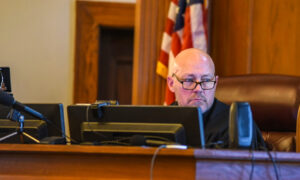17:42
News Story
‘Historic moment’: Lamar Johnson wrongful conviction case goes before a St. Louis judge
James Howard, who is serving a life sentence, testified Monday that he killed Marcus Boyd in 1994 – not Lamar Johnson

Lamar Johnson listens to testimony on Dec. 13, 2022, in St. Louis Circuit Court (pool photo by David Carson, [email protected]).
St. Louis Circuit Attorney Kimberly Gardner has waited more than three years for the chance to argue the innocence of Lamar Johnson, who was convicted of murder in 1995.
She finally got the hearing to set aside Johnson’s murder conviction on Monday, day one of a trial expected to last all week.
“This is a rather historic moment in this court,” said Special Assistant Circuit Attorney Charlie Weiss in his opening statement Monday. “It’s the first time in the 22nd Circuit Court the court is hearing an actual innocence claim filed by the prosecuting attorney.”
The case began in 2019 when Gardner filed a motion for a new trial for Johnson, the first exoneration case for her conviction-integrity unit.
The effort was squashed when the Missouri Supreme Court ruled in March 2021 that prosecutors didn’t have the right to ask for a new trial in cases of innocence or wrongful prosecution.
A few months later, state legislators passed a law giving prosecutors a pathway to file motions to vacate sentences.
So in August, Gardner filed a 59-page motion recounting the details of Oct. 30, 1994, when Marcus Boyd was shot and killed on his front porch. She argued it was Phillip Campbell and James Howard who killed Boyd, and not Johnson.
On Monday, Gardner’s team walked Circuit Judge David Mason through those details and called their first witness — Howard, who confessed to killing Boyd.
“Me and Phillip Campbell killed him on his front porch,” Howard said Monday.
Mason asked Howard repeated questions about the murder, particularly about his motive.
The judge also had many questions for Greg Elking, the only eye witness who also testified Monday. Elking said police detectives and the prosecutor “pressured” and “bullied” him into identifying Johnson from a lineup.
In 2019, Gardner’s investigators found old files in the Circuit Attorney’s office where Elking was allegedly paid more than $4,000 after he picked Johnson out of a line up. However, the documentation for these payments was never provided to the defense, even though Johnson’s lawyers requested it repeatedly over the years.
Mason asked why those payments didn’t get into the trial.
“Isn’t it something the prosecutor would have known about?” Mason asked.
“Yes, your honor,” Weiss replied.
Gardner’s investigator will testify about finding the payments in the prosecutor’s old records, Weiss told Mason.
Miranda Loesch, arguing the case on behalf of the Attorney General’s Office, said the former circuit assistant who prosecuted the case and the police detective who investigated it followed all the appropriate procedures.
And Howard’s testimony — that he killed Boyd instead of Johnson — is not credible. Johnson, Loesch argued, is guilty of murder.
“He’s a convicted murderer,” she said of Howard. “What does he have to lose from coming in here and talking?”
Under the 2021 state law, if a prosecutor files a motion to vacate or set aside a judgment, the attorney general’s office could appear, question witnesses and make arguments at the hearing.
But the attorney general is not a party in the case.
If Gardner wins, then that’s the end of the attorney general’s involvement. Gardner will likely not call for a new trial, and Johnson will go free.
But if the prosecutor loses, they could file an appeal and the attorney general could file a motion to intervene or dismiss the appeal.
The murder

Boyd was sitting on the front porch of his apartment with his co-worker Elking, who had come to purchase some drugs.
Two black men wearing ski masks — who Gardner is now confident were Campbell and Howard — ran up from the side of the house without warning.
The men shot and killed Boyd, but Elking escaped and ran home.
At the time of the crime, Weiss said Johnson and his girlfriend were at their friend’s apartment located at 3907 Lafayette in St. Louis, at least 10 minutes by car from the scene at 3910 Louisiana.
In his opening argument, Weiss said that Elking was pressured to identify Johnson as the killer so he could have protection from potential retribution and to receive support to move to a safer home.
Elking later wrote a letter to his pastor that confessed to knowing what he did was wrong and trying to atone for his sins. This letter was included in Gardner’s August motion.
The late Phillip Campbell pleaded guilty to voluntary manslaughter and received a sentence of 7 years, which he served.
Days after Johnson was convicted, Weiss said Campbell wrote letters to Johnson saying that he was sorry and that he knew he was innocent.
Before Johnson was sentenced, the prosecutor called for a search warrant to seize those letters.
“That’s how we got them, they were in the prosecutor’s records,” Weiss said.
In letters seized after Johnson’s conviction, the motion states that Campbell identified the second shooter as James Howard, who lived down the street from Boyd.
Both Campbell and Howard have signed multiple affidavits confirming that they, and not Johnson, killed Boyd.
Howard’s testimony
It wasn’t Howard’s plan to kill Boyd that night, Howard said in his testimony Monday.
He simply meant to rob Boyd, as a favor to his then-best friend Sirone Spate, who was Boyd’s partner in selling crack cocaine. That night, he was hanging out with Spate at Howard’s mother’s house, which was on the same block as Boyd’s house.
Spate had been complaining that Boyd was cheating him out of money, and he learned Boyd was at his house. Howard, who was 17 at the time, and Campbell put on a ninja-style black mask and black clothing and went down the alley to Boyd’s house to try and rob Boyd’s safe box, Howard testified.
When they got there, they tried to get Boyd to go into the house, but Boyd resisted. In the heat of the moment, Campbell shot Boyd in his side and Howard shot him in the back of the head, he said, then they ran back to his mother’s house.
He didn’t come forward once he learned Johnson was arrested and charged with the murder.
“I didn’t think they’d convict him because he had nothing to do with it,” Howard said.
When Howard learned Campbell told Johnson that he was the other shooter, Howard said he was “pissed” at first.
“We’re street people, that’s just what we do,” Howard said. “But then I got to think about it. If I knew someone was sitting in prison for a murder he didn’t commit, I would probably would have done it too.”
Howard hasn’t seen Johnson for 17 years, and he’s tried to avoid him because it made him feel bad.
“Just seeing him doing time for something he didn’t do, it bothered me,” he said.
Testifying Monday was a way to “right his wrongs,” he said.
In her cross examination, Loesch asked if Johnson had been in his same gang, and Howard said “yes.”
Loesch pulled out affidavits Howard had signed previously, where there were discrepancies in the route Howard and Campbell took to get to Boyd’s house and when they left the scene of the crime.
“So you lied?” Loesch said.
Howard replied he didn’t write the affidavits, and he didn’t proofread them.
“What I can tell you is that I shot him,” Howard said. “The very hard stuff I can recall for you. The tiny details, this was 30 years ago, I can’t give you that.”
Loesch asked Howard about serving 345 years for various crimes, including another murder charge.
Howard interrupted Loesch and said, “Ask me how he died. I killed him the exact same way I killed Boyd.”
He put it directly on his head, he said, “barrel to skin.”
Greg Elking’s testimony

Greg Elking lived blocks away from Marcus Boyd in South St. Louis, and they also worked together at a printing company and sometimes carpooled. On night of the murder, Elking testified that he was trying to buy drugs from Boyd when the two gunman came up to the porch with their guns drawn.
In a matter of seconds, the gunmen were wrestling with Boyd and then one of them shot him in the back of the head. The other shot him in the side of his body. The shots were so close, Elking said, it looked like they were “lighting up” Boyd’s body.
Elking told police that he couldn’t identify the killers because they had masks on. When the detective, Nickerson, showed him photos of potential suspects, he said, “I don’t know what these photos would be good for.”
Elking agreed to participate in a line up because he wanted to help, he said, and the detectives talked to him like they were confident they knew who the killers were.
Also, he said some detectives insinuated that he could be an accessory to murder if he didn’t help them identify someone.
“I’d just seen a guy murdered,” Elkins said, also noting that Boyd was a friend. “Not only was I being bullied, I wanted to help. I hate it and I’ve been living with it for 28 years. I just wish I could change time.”
He and his wife were behind on rent and all their bills, and the detectives said they could provide safe housing outside of the city.
After he picked Johnson out of a lineup, he was provided money for rent until he testified in the trial.
At 5 p.m., Mason paused Elking’s testimony and recessed until Tuesday morning.
In a motion filed Friday, Attorney General Eric Schmitt accused Gardner of withholding a lab report regarding gun residue on Johnson’s jacket when he was arrested four days after the murder.
“The Circuit Attorney has simultaneously alleged that Lamar Johnson is actually innocent and concealed forensic testing showing gunshot residue on Johnson’s jacket,” Schmitt’s motion stated.
Gardner responded that the report didn’t exist when Schmitt first asked for all reports and the lab didn’t title it in a way that identified it as part of Johnson’s case. Also, Johnson wasn’t wearing the jacket at the time of the murder.
“This is a weak attempt to change the narrative because the Attorney General has no case,” she said.
On Friday night, the judge issued an order that did not grant the request for sanctions and stated that the issue of the jacket’s relevance would be taken up with the case.
Our stories may be republished online or in print under Creative Commons license CC BY-NC-ND 4.0. We ask that you edit only for style or to shorten, provide proper attribution and link to our website. AP and Getty images may not be republished. Please see our republishing guidelines for use of any other photos and graphics.




